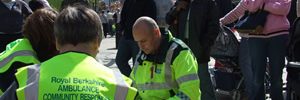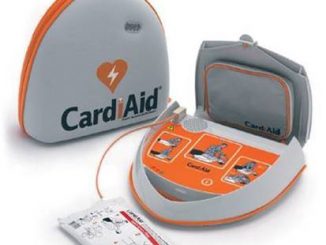What does a Defibrillator do?
It detects and stops the random electrical activity occurring in a heart during a Cardiac Arrest by applying a large burst of energy across the heart. This gives the heart’s built-in pacemaker a chance to take control again
So it doesn’t start the heart, then?
No, quite the opposite.
What if the heart is beating? Won’t that be a problem?
When you stick the pads to the patient’s chest it takes a few seconds to analyse the heart’s rhythm. It knows which rhythms can and which cannot be shocked. It will not let you shock an unshockable rhythm (such as a normal heartbeat)
Will I get a shock if I’m touching the patient?
It’s best not to be touching the patient and to make sure that no-one else is touching the patient. If you do happen to be touching them, then yes, you will get a shock but it is unlikely to do you serious harm
Can I use it on someone who is pregnant or a child or a baby?
Pregnant ladies – yes, absolutely. If necessary move the pads slightly so they are away from the enlarged breasts.
Children and babies – yes. If you have paediatric pads that attenuate (reduce) the power settings, use them, otherwise use adult pads. Evidence for their effectiveness when used on babies under 1 is limited, but on balance it is probably better to give a shock than nothing at all.
What is supplied with the Defibrillator?
The defibrillator will come in a carry case. The carry case will have a pouch that should contain the following:
- Towel – for wiping chest dry if water-related
- Razor – for clearing chest hair from where the pads are due to go
- Gloves – for personal protection
- Pocket mask / Face mask – for protection during mouth-to-mouth
It might also contain the following:
- Spare Adult pads
- Paediatric pads – for adjusting the power delivered. If paediatric pads are not available, use adult pads down to about 1 year. If you cannot place the pads as indicated with a separation of a complete pad’s width, then consider using them on the front and back of the chest instead
The defibrillator is locked inside a cabinet
On hte front of the cabinet will be a keypad. When you dial 999, tell them the location code on the cabinet and they will tell you the code to get in.
So can I make a patient worse?
No. If their heart is not beating properly, they are dead. Shocking them with a defibrillator is not going to make them worse, but might make them better. If their heart is beating properly, the defibrillator will not let you shock them.
The only damage you can do to someone with an AED is if you whack them around the head with it.
Professor Douglas Chamberlain



Be the first to comment